|
|
|
Sort Order |
|
|
|
Items / Page
|
|
|
|
|
|
|
| Srl | Item |
| 1 |
ID:
147765
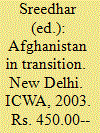

|
|
|
|
|
| Publication |
New Delhi, ICWA, 2003.
|
| Description |
231p.hbk
|
|
|
|
|
|
|
|
|
|
|
|
Copies: C:1/I:0,R:0,Q:0
Circulation
| Accession# | Call# | Current Location | Status | Policy | Location |
| 058817 | 320.9581/SRE 058817 | Main | On Shelf | General | |
|
|
|
|
| 2 |
ID:
107149
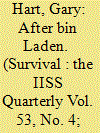

|
|
|
|
|
| Publication |
2011.
|
| Summary/Abstract |
The Cold War ended 20 years ago. NATO has yet to define a twenty-first- century mission. New allies and new rivals are emerging. There are new security threats that do not lend themselves to military response and that cannot be addressed either by old alliances or by the United States alone, and the nature of warfare and the character of conflict themselves are changing. The United States' national predisposition, however, has been to rely on traditional institutions and policies and to use them to address unfolding history on its own timetable.
|
|
|
|
|
|
|
|
|
|
|
|
|
|
|
|
| 3 |
ID:
132864
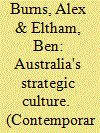

|
|
|
|
|
| Publication |
2014.
|
| Summary/Abstract |
This article draws on fourth generation strategic culture debates to show the gap between the rhetoric of Australian defence and the more modest reality. Our analysis shows that these limits derive from tensions between national strategic culture and organizational strategic subcultures. There are serious debates in the nation regarding the preferred course of the Australian military and security policy. This article frames these debates by examining the 'keepers' of Australia's national strategic culture, the existence of several competing strategic subcultures, and the importance of norm entrepreneurs in changing defence and national security thinking. Strategic subcultures foster compartmentalization, constraints, and bureaucratic silos that narrow national conceptions of security threats and opportunities, and impinge on the formation of coherent foreign and defence policy in relation to the Asia-Pacific region. This analysis shows that a distinct national strategic culture and organizational strategic subcultures endure beyond individual governments, placing potential limits on Australia's interface with other Asia-Pacific strategic cultures in the future.
|
|
|
|
|
|
|
|
|
|
|
|
|
|
|
|
| 4 |
ID:
073058
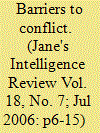

|
|
|
| 5 |
ID:
109807
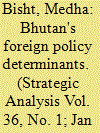

|
|
|
|
|
| Publication |
2012.
|
| Summary/Abstract |
This article assesses the shifting preferences of Bhutan towards the foreign policy determinants. Three determinants (national security, political culture and economic engagement) have been studied as they play a significant role in shaping Bhutan's policy behaviour. These determinants have been analysed with respect to India, Nepal and China, three countries that have been of critical interest to Bhutan's foreign policy. The main argument of the paper is that when security threats are high or medium, protecting territorial integrity, sovereignty and political culture shapes Bhutan's foreign policy and, alternatively, when security threats are low, economic opportunities determine Bhutan's foreign policy choices.
|
|
|
|
|
|
|
|
|
|
|
|
|
|
|
|
| 6 |
ID:
126249
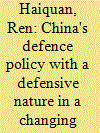

|
|
|
| 7 |
ID:
132868
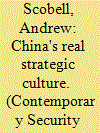

|
|
|
|
|
| Publication |
2014.
|
| Summary/Abstract |
The Great Wall is frequently held up as the most striking symbol of the potency of a persistent Chinese pacifist, non-expansionist, defence-minded strategic stance. But how accurate is this 'Great Wall' depiction of China's strategic culture? What is the impact of this depiction on China and the Asia-Pacific region? While the Great Wall is an apt symbol of a romanticized image of Chinese strategic culture, the reality behind the genesis of this impressive fortification and the accompanying pervasive belief in a monistic strategic tradition is that they are figments of the collective contemporary Chinese imagination. Nevertheless, these formidable myths exert real influence on two 'faces' of strategic culture. The first face refers to how leaders and society perceive the policies and actions of their own country. The second face, routinely neglected, refers to how leaders and society in one state perceive the policies and actions of an adversary or potential adversary state, which, like the first face, is constructed out of myth. The impact of these two faces on the Asia-Pacific region exacerbates the region's security dilemma, adversely impacting China's relations with other countries, notably Japan and the United States.
|
|
|
|
|
|
|
|
|
|
|
|
|
|
|
|
| 8 |
ID:
091817
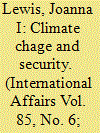

|
|
|
|
|
| Publication |
2009.
|
| Summary/Abstract |
The environment is increasingly affected by global climate change. While the causes of climate change are generated across the globe, the impacts of climate change will be highly variable at the local level. An increased scientific understanding of the potential impacts that climate change may have within China has raised new concern among China's leaders. Given that China's domestic realities inform its international policy choices, understanding how climate change may affect its population and natural resources is critical to global climate stabilization efforts. This article examines how the impacts of climate change on China, and China's response, will drive security challenges domestically, as well as in the greater Asian region and around the world. It shows that the impact of climate change on China will be significant and may have sizable adverse economic implications, particularly on vulnerable east coast economic centers. Water scarcity is a problem that already challenges China's leadership and one that will be exacerbated under projected climate impacts. In addition, the country faces the risk of international retaliation should it fail to undertake serious greenhouse gas mitigation actions. Yet China is not without options, and is already well poised to become a leader in the low-carbon technology revolution.
|
|
|
|
|
|
|
|
|
|
|
|
|
|
|
|
| 9 |
ID:
093827
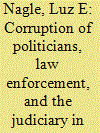

|
|
|
|
|
| Publication |
2010.
|
| Summary/Abstract |
Mexico is a failing state, languishing under a deeply entrenched system of political corruption that undermines the three branches of government and compromises Mexico's law enforcement and national security capabilities. This article explores the culture of corruption that pervades the state and frustrates the rule of law in Mexico, examining how the political elites, the judiciary, and police officials embrace corruption as a primary means for career advancement and for acquiring personal wealth. It is an examination of a country overwhelmed by a system of government and commerce that has grown dependent on corruption in order to function. But such a system cannot sustain itself indefinitely, and the signs of the Mexican state's collapse are becoming more apparent in the wake of unprecedented political and social violence at the hands of corrupt actors and Mexican drug lords.
|
|
|
|
|
|
|
|
|
|
|
|
|
|
|
|
| 10 |
ID:
090411
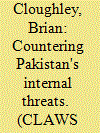

|
|
|
|
|
| Publication |
2008.
|
| Summary/Abstract |
There are two main types of internal violence occupying the attention of the army in Pakistan: the comparative new but ever-present threat of suicide bombings, many specially directed against military personnel and bases; and ongoing conflict in the Northwest Frontier Province (NWFP) and Balochistan. Both are major challenges and the latter requires extensive specialist training, while achieving balance in force structure and capabilities is proving time-consuming and expensive.
|
|
|
|
|
|
|
|
|
|
|
|
|
|
|
|
| 11 |
ID:
127201
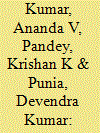

|
|
|
|
|
| Publication |
2014.
|
| Summary/Abstract |
India is poised to spend over USD 5.8 billion as part of the National Smart Grid Mission aimed to alleviate India's ailing power sector as part of its 12th Five year plan (2012-2017). The federal government sponsored Restructured Accelerated Power Development and Reforms Program (R-APDRP) is also focused on building ICT capability in the state electricity boards. Presently however, there is no power sector specific cyber security mandates or policies in India. The Stuxnet, Shamoon and Anonymous incidents have shown that cyber attacks can cause significant damage and pose a risk to National Critical Infrastructure. A lack of security planning as part of designing the Smart grids can potentially leave gaping holes in the country's power sector stability. The paper highlights key cyber security threats across the entire power sector value chain-from generation, to transmission and distribution. It is aimed at building the case for power sector specific cyber security regulations based on the experience of regulators in other critical infrastructure sectors like Banking and Telecom in India and power sector regulations internationally.
|
|
|
|
|
|
|
|
|
|
|
|
|
|
|
|
| 12 |
ID:
153608
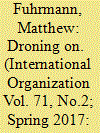

|
|
|
|
|
| Summary/Abstract |
Unmanned Aerial Vehicles (UAVs), more popularly known as “drones,” have become emblematic of twenty-first century military technologies but scholars have yet to convincingly explain the drivers of UAV proliferation. Using the first systematic data set of UAV proliferation, this research note examines the spread of UAVs in the context of scholarly debates about interests versus capacity in explaining policy adoption. The results yield important insights for both IR scholarship and the policy-making community. While countries that experience security threats—including territorial disputes and terrorism—are more likely to seek UAVs, drone proliferation is not simply a function of the threat environment. We find evidence that democracies and autocracies are more likely than mixed regimes to develop armed UAV programs, and suggest that autocracies and democracies have their own unique incentives to acquire this technology. Moreover, supply-side factors play a role in the UAV proliferation process: a state's technological capacity is a strong predictor of whether it will obtain the most sophisticated UAVs. The theories and evidence we present challenge emerging views about UAV proliferation and shed useful light on how and why drones spread.
|
|
|
|
|
|
|
|
|
|
|
|
|
|
|
|
| 13 |
ID:
124937
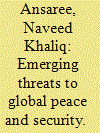

|
|
|
| 14 |
ID:
111791
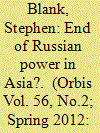

|
|
|
| 15 |
ID:
129227


|
|
|
| 16 |
ID:
157539
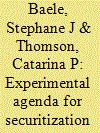

|
|
|
|
|
| Summary/Abstract |
Securitization theory has developed into a fruitful research program on the construction of security threats. The theory has experienced growing sophistication, and empirical studies have produced stimulating insights on issues as varied as the politics of immigration, health, climate change, or cybersecurity. Understanding how social issues become perceived as threats seems timelier than ever given the rise in securitizing narratives in recent political elections across the globe. We propose that this research agenda would benefit from broadening its methodological diversity. In particular, the use of experiments could complement existing methods in securitization theory, mitigate some of the program’s methodological weaknesses, and help explain when securitizing moves are likely to succeed or fail.
|
|
|
|
|
|
|
|
|
|
|
|
|
|
|
|
| 17 |
ID:
122923
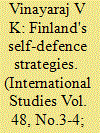

|
|
|
|
|
| Publication |
2011.
|
| Summary/Abstract |
The essay examines the threats and challenges that Finland has perceived first from imperial Russia, then from the Soviet Russia and now from the Russian Federation. Apart from studying the dynamics of Finland-Russia relations, it looks specifically at the Finnish responses for ensuring its sovereignty, independence and territorial integrity in general and the self-defence strategies adopted by Finland in dealing with potential threats from Russia in particular. This is done in the context of Paul Schroeder's categorization of self-defence strategies.
|
|
|
|
|
|
|
|
|
|
|
|
|
|
|
|
| 18 |
ID:
135233
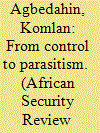

|
|
|
|
|
| Summary/Abstract |
This article sets out to investigate the current paradoxical roles of border control agencies in order to contribute to the theoretical debate on border porosity and related security issues in West Africa. The colonial demarcation of African borders accounts for their porous nature initially, as borderland populations challenged the unjust scission of their cultural, economic, geographical and geopolitical spaces. However, new forms of porosity also evolved over time, masterminded by new actors. Drawing on the Ghana–Togo border case, and through interviews, observation and documentary analysis, this article argues that border control agencies are partly responsible for the current border porosity and attendant security problems as their jurisdiction has shifted to a multi-layered border parasitism. The article is not, however, an attack on border law enforcement agencies; rather it attempts to explore their roles in shielding the region, already exposed to terrorism and piracy, from further security threats.
|
|
|
|
|
|
|
|
|
|
|
|
|
|
|
|
| 19 |
ID:
072813
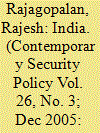

|
|
|
|
|
| Publication |
2005.
|
| Summary/Abstract |
India has been pursuing missile defences for a decade. Its missile defence programme is determined more by political than military imperatives, and it appears to be driven primarily by concerns about the threat posed by Pakistan's missile force, with little direct consideration of China. There is little indication that Indian decision-makers have thought through the kind of missile defence architecture that is needed for this emerging requirement, or the political implications of deploying a missile defence system. India's democratic polity has had little influence on decision-making on missile defences, though this is by itself not unusual since strategic policy has rarely invoked much interest or debate in India. But missile defences also sit uneasily with or even contradict other aspects of India's nuclear doctrine, and these contradictions have not yet been addressed.
|
|
|
|
|
|
|
|
|
|
|
|
|
|
|
|
| 20 |
ID:
096764
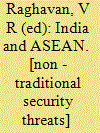

|
|
|
|
|
| Publication |
Chennai, East West Books, 2007.
|
| Description |
x, 319p.
|
| Standard Number |
9788188661565, hbk
|
|
|
|
|
|
|
|
|
|
|
|
Copies: C:1/I:1,R:0,Q:0
Circulation
| Accession# | Call# | Current Location | Status | Policy | Location | IssuedTo | DueOn |
| 055018 | 327.54059/RAG 055018 | Main | Issued | General | | RF171 | 23-Feb-2024 |
|
|
|
|
|
|
|
|
|